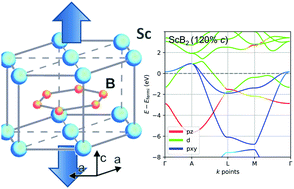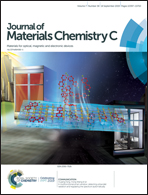Strain to alter the covalency and superconductivity in transition metal diborides†
Abstract
Among layered metal diborides, MB2, only MgB2 is a superconductor. We explicate the details of the chemical bonding in the diboride series, and, based on those, propose a strategy for the application of anisotropic mechanical stress that could lead to the superconducting behavior in some transition metal diborides, particularly in ScB2. The key aspect detrimental to superconductivity is found to be the covalent metal–boron bonding enabled by the presence of d-electrons on the metal. We show that, based on the differential response to electronic states of different angular momenta to anisotropic strain or compression, the covalent overlap can be strategically manipulated. The metal–boron covalency in ScB2 can be removed when the lattice is compressed along the ab-direction, or stretched along the c-direction. Both types of stress are characterized by the rise of the degenerate σ-band toward crossing the Fermi level. The elongation along c also softens the degenerate E2g phonon that can split this σ-band to produce Cooper pairs. More generally, while the effect of mechanical stress on superconductivity has been seen before, it was not known what exactly the stress achieves. Here we explicate this on the example of a particular alloy family. Our findings can lead to strategies for choosing the type and strength of mechanical stress for the manipulation of materials’ vibronic structures toward superconductivity.



 Please wait while we load your content...
Please wait while we load your content...